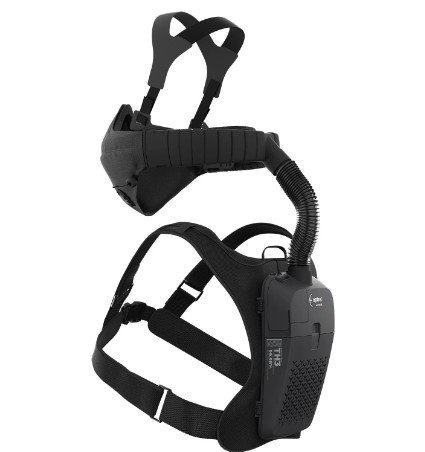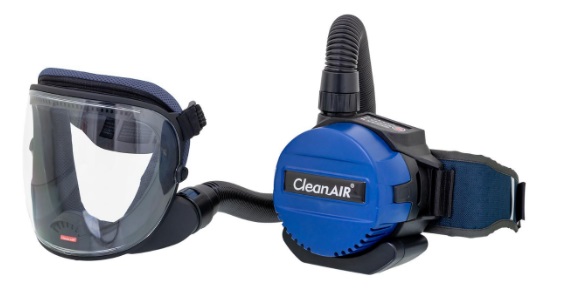In the area of WHS on respiratory protection, there are two common issues:
1. Workers with facial hairs, such as a beard, present an issue when selecting a proper respirator for respiratory protection, as tight-fitting PAPRs are not recommended, which limits the choice of selection.
2. Even if workers are clean-shaven, for many organizations, the annual fit-testing is a pain and burden, as it is time-consuming and costly, especially when the workforce is large or has a high turnover rate.
However, although loose-fitting PAPRs like 3M Versoflo are a good fit for some niche applications, it is by no means the most suitable solution for many other work conditions, such as:
- Works that require frequent heavy physical exertions and movement, the headtop, hose and belt-mounted heavy Power unit are quite troublesome.
- Works that need frequent donning and doffing, PAPRs with headtop+hose+belt-mounted Power units are pain and nonsense for productivity.
- For very dusty works, such as stone cutting and grinding, bulky PAPRs like 3M Versaflo are difficult to clean daily.
- Works that don’t need head protection, PAPRs that must work with a headtop are overkill or not convenient.
- Work conditions that need higher protection that most loose-fitting PAPRs can’t provide.
- PAPRs like 3M Versaflo are quite expensive and not an economical and value-for-money solution for many applications.
All the above shortcomings could be resolved by PAPRs with facepieces without helmets, hose, and belt-mounted Power units, provided the facepieces of either half-face or full-face can be both tight-fitting and loose-fitting, such that they don’t require a fit test when a lower level of protection can be accepted, but can provide higher protection when fit-tested.
Here comes the question of this article: Can Facepieces be loose-fitting?
If we refer to AS/NZS 1715-2009, it defines both half facepiece and full facepiece as tight-fitting devices.
The Standard also demands a suitable fit test to be carried out for RPE with a tight-fitting facepiece.
Note that, the definition of a fit test requires testing the fit during the Power Off mode of a PAPR. Surely, with hairs present between the facepiece and the facial skin, the fit test will fail miserably.
Therefore, the Standard goes further by stating that no one who requires respiratory protection shall wear either a full facepiece or half facepiece RPE over a beard.
Here is our rationale:
- Facepieces don’t have to be tight-fitting to provide good protection. Powered respirators normally rely on generating positive pressure in the facepieces to achieve protection. Even AS/NZS 1715:2009 acknowledges that positive pressure RPE may diminish the effect of poor facial fit.
- Recent products from Europe show both half facepieces and facepieces loose-fitting PAPRs. For example, Optrel Swiss Air System and CleanAIR Unimask for Basic PAPR.
 |
 |
The new ISO respiratory standard ISO 16973-2023 specifies Respiratory Interface Classes with loose-fitting for a few types of facepieces as below:

- We have repeatable fit test data at Power On mode for our facepiece-based PAPR AYO WX, and our data show a similar fit factor for a bearded person to a clean-shaven person, indicating good protection for our PAPR on a person with facial leaks, and demonstrating that PAPRs could provide good protection without a tight-fitting.
- Therefore, we can expect a suitable PAPR with a loose-fitting facepiece to provide a good level of protection, although it may not provide the same protection as a tight-fitting PAPR when the pressure in the facepiece becomes negative.
- Further, we have the view that a tight-fitting PAPR could be used as a loose-fitting PAPR provided that we accept the protection level is less than the PAPR with a user being clean-shaven and properly fit-tested.
To this end, European Standards are written more appropriately by having EN 12942 for tight-fitting PAPRs and EN 12941 for loose-fitting PAPRs, where EN 12942 needs to test in Power On and Off modes, which makes sense for tight-fitting PAPRs, and EN 12941 tests in Power On mode only, which makes sense for loose-fitting PAPRs.
The highest class in EN 12942 is TM3, and the highest class in EN 12941 is TH3, where TM3 is 4 times better protection than TH3, this also makes sense.
So the ultimate issue/bottleneck in Australia is whether or not AS/NZS1715 and AS/NZS 1716 can be updated to recognize facepieces can be loose-fitting, and the protection level differences between tight-fitting and loose-fitting PAPRs.
Before this can happen, organizations with many bearded workers or high turnover rates have to rely on open minds and sound judgment from decision-makers, in particular, occupational hygienists in qualifying more suitable respirators that are otherwise not permitted to use if following the current Australian Standards dogmatically.
As a respirator designer and manufacturer, Aimwell believes AYO WX Around-neck PAPR series can normally work as both tight-fitting and loose-fitting and are better suited for a wide range of worksites and conditions than loose-fitting only PAPRs due to AYO WX unique practicality and flexibility by design.
About the author:
Eric Fu, founder and managing director of Aimwell, has over 25 years of experience in breathing device design and manufacture.
